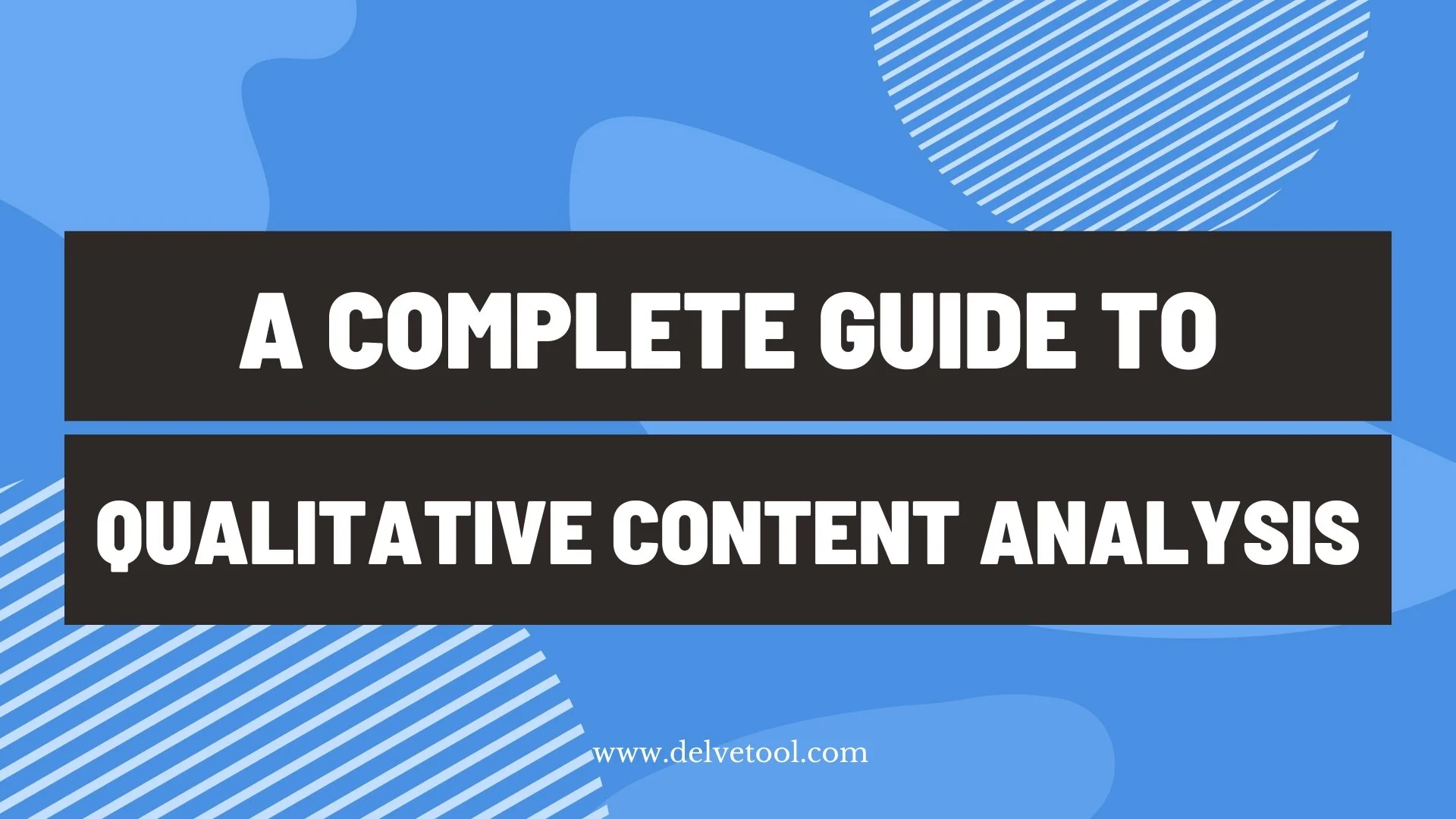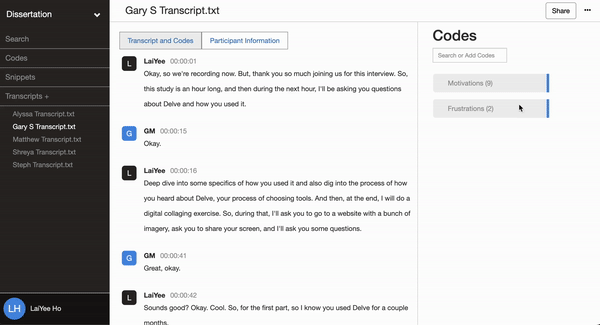The Practical Guide to Qualitative Content Analysis
What is Qualitative Content Analysis?
Qualitative content analysis is a research method used to analyze and interpret the content of textual data, such as written documents, interview transcripts, or other forms of communication.
It provides a systematic way to identify patterns, concepts, and larger themes within the data to gain insight into the meaning and context of the content.
This guide introduces qualitative content analysis. We also cover many types of qualitative content analysis and address the conflicting ways this topic is presented in the research literature. Lastly, we will provide a step-by-step guide to how to conduct qualitative content analysis.
Qualitative vs. Quantitative Content Analysis
What is content analysis?
At a top level, content analysis in research allows you to examine and understand the content of textual data. There are two types of methodological approaches to content analysis: quantitative content analysis and qualitative content analysis.
The term “qualitative content analysis” can be misleading because it often uses many quantitative elements. For this reason, it is helpful to clearly define each approach to show where this overlap in qualitative content analysis occurs.
What is quantitative content analysis?
Quantitative content analysis is a research method that systematically measures the presence and frequency of specific words, phrases, or themes in a large sample of texts. It uses a numbers-based method to identify patterns that can answer “how much”, “how many” or “how often”. That is to say that the process is purely empirical.
What is qualitative content analysis?
Qualitative content analysis answers “why”, “how”, or “what”. Through an iterative process of coding, counting, and interpretation, it explores the subtleties of data in a way the quantitative method does not. That said, qualitative content analysis often relies on quantifying the frequency of words, phrases, and concepts to provide such answers.
Learn about qualitative vs. quantitative data types on Delve’s Youtube channel.
Framing the relevance of frequency
Frequency refers to how often keywords, concepts, or themes are used within the analyzed content. That frequency is often used to signify relevance within a data set.
Most types of qualitative content analysis utilize frequency to identify which concepts may warrant further exploration. However, unlike quantitative content analysis, frequency is not considered a final result in this method. It only indicates a pattern that may deserve probing.
Research that stops at frequency is quantitative content analysis. But in qualitative content analysis, you go “beyond merely counting words to examining language … for the purpose of classifying large amounts of text into … categories that represent similar meanings.” [1]
Now that we've differentiated these approaches to content analysis let's explore how qualitative content analysis differs from other types of qualitative research methods.
Qualitative Content Analysis vs. Other Qualitative Research Types
As we have discussed, frequency is a standard tool in qualitative content analysis. This is not the case in other qualitative research methodologies, such as thematic analysis and grounded theory.
For example, when conducting thematic analysis, novice researchers are often warned not to equate frequency with relevance. In contrast, qualitative content analysis papers often include frequency tables or statistical graphics in the final analysis and write-up.
You can read more on this topic in our blog, contrasting content analysis with thematic analysis.
Defining Qualitative Content Analysis, According to the Experts
Perhaps you landed on this guide because you could not find a satisfactory definition of qualitative content analysis. In fact, one of the reasons we wrote this guide was our frustration at the lack of clarity on this topic—even among the most cited experts on this subject.
No single source of information offers a universal definition for qualitative content analysis. For such a widely practiced research method that is growing in popularity, there is an enormous void of information on what, when, or how to use it. We aim to offer clarity through this guide.
Researchers agree that identifying patterns within data adds context, making it easier to interpret large amounts of information. As a result, they get a stronger grasp of the content they are analyzing. That might be the simplest definition that captures all of the following definitions.
Frequently cited definitions of qualitative content analysis:
“Allows researchers to understand social reality in a subjective but scientific manner.” (Zhang & Wildemuth, 2009)
“A research method for the subjective interpretation of the content of text data through the systematic classification process of coding and identifying themes or patterns.” (Hsieh & Shannon, 2005)
“A flexible method for making valid inferences from data in order to provide new insight, describe a phenomenon through concepts or categories, and develop an understanding of the meaning of communications with a concern for intentions, consequences, and context.” (Elo & Kyngäs, 2008)
“Represents a systematic and objective means of describing and quantifying phenomena.“ (Downe-Wamboldt, 1992)
“An approach of empirical, methodological controlled analysis of texts within their context of communication, following content analytic rules and step-by-step models, without rash quantification.” (Mayring, 2000)
“Any qualitative data reduction and sense-making effort that takes a volume of qualitative material and attempts to identify core consistencies and meanings.” (Patton, 2002)
After exhaustively researching this topic, we feel our initial definition offers a general consensus of what these researchers have offered. We included this section because we felt it important to convey the many different ways experts define and discuss qualitative content analysis.
Try Delve, Software for Qualitative Coding
Online qualitative research software such as Delve can help streamline how you’re coding your qualitative coding. Try a 14 day free trial of Delve.
When Should I Use Qualitative Content Analysis?
Qualitative content analysis can be used in various research contexts, including social science, psychology, marketing research, education, and business.
It is often used to explore complex phenomena, such as attitudes, beliefs, and social interactions. By exploring these topics, researchers gain a deeper understanding of the perspectives and experiences of individuals, groups, and even institutions.
Qualitative content analysis is a notoriously flexible research method with no strict guidelines for when or how to employ it. The Columbia’s Mailman School of Public Health suggests using content analysis to, along with a few additions of our own:
Study and sample data from large amounts of text.
Analyze open-ended survey responses to understand patterns in participant experiences.
Figure out what a person, group, or organization is trying to achieve, what they are talking about, and how they communicate their ideas.
Explain how people react to messages in terms of their attitudes and behaviors.
Determine the psychological or emotional state of persons or groups.
Reveal international differences in communication content.
Analyze interviews and open-ended questions to complement quantitative data.
When you don’t have the time or resources to conduct focus groups or interviews.
Source Materials for Qualitative Content Analysis
Source materials used to conduct qualitative content analysis can be any text-based communication, including:
Survey responses and open-ended questionnaire data
Focus group transcripts from survey follow-ups
Newspapers
Transcribed news stories
Transcribed speeches
Historical documents
Magazines
Web-based content (including social media posts);
Transcribed films and documentaries
Field research notes
Books
Essays
Poems
Applying Content Analysis to Survey Responses
While this guide mostly focuses on coding interviews, survey responses also offer an interesting application for content analysis. When you're working with open-ended survey questions, you get something different from interviews. Responses are typically more concise and targeted, since participants are answering specific prompts rather than having flowing conversations.
This focused nature actually makes surveys quite suited to content analysis. You can easily compare how different groups – say, undergraduate versus graduate students, or people from different geographic regions – respond to the same question. The structured format also gives you flexibility in your approach, which allows for both deductive analysis (testing predetermined themes) and inductive discovery of unexpected patterns.
For instance, if you're analyzing responses to "What challenges did you face during remote learning?", you might begin with expected themes like "technology issues" and "social isolation" from prior research. But you also stay open to discovering unexpected patterns like "childcare conflicts" or "workspace limitations" that you spot within your specific dataset.
A Brief History of Qualitative Content Analysis
The origins of qualitative content analysis can be traced back to the early 20th century when social scientists began using content analysis to study media messages. For instance, when researchers wanted to study newspapers or propaganda en masse.
However, the formal development of content analysis as a qualitative research method really began in the 1950s, when researchers in various social sciences began using it to analyze various types of texts that could be any of the sources mentioned above.
Content Analysis: Then & now
In the early days of content analysis, the focus was mainly on counting and categorizing the frequency of specific words or concepts in texts. As the method developed, researchers began to use content analysis more interpretively, analyzing not just the frequency of specific words or concepts but also the meanings and contexts in which they were used.
Over the years, various approaches and submethods have been developed from this original format.
Today, content analysis remains a popular qualitative research method used by researchers in a wide range of fields to study various textual materials.
Inductive Versus Deductive Content Analysis
When you use qualitative content analysis for your research, the first step is generally to collect the data you want to analyze.
After you have collected your data, there are different ways to analyze it. Depending on your research question, the data available, and your research goals, you will likely choose an inductive approach, a deductive approach, or a combination of both.
Inductive content analysis
Inductive content analysis is a bottom-up approach to meaning-making that starts with no preconceived codes or theories. Instead of using a preexisting framework or previous research, you develop a theory from scratch (the bottom) as you analyze the entire data set.
With inductive content analysis, you develop your codebook by immersing yourself in your data. It offers flexibility to adjust codes and theories as you progress through your analysis. You can then refine your understanding of the data and explore unexpected findings.
This approach is often better suited for identifying latent content—or meaning that is not immediately apparent “on the surface” of the text.
[Related readings: Latent Content Analysis vs Manifest Content Analysis]
✅ Advantages of inductive content analysis
Offers an exploratory way to answer research questions.
It is helpful when there is little existing literature on the topic.
It helps explore multiple perspectives and viewpoints on a topic.
It offers a flexible approach to data analysis.
❌ Disadvantages of inductive content analysis
It can be hard to balance immersion in the data and analyzing the data.
Struggling to strike this balance can be a time-consuming process.
Inter-coder reliability can be challenging as the coding categories are not predefined.
Analysis may be influenced by a researcher’s personal biases and preconceptions.
Types of inductive content analysis
Conventional Content Analysis - With Conventional Content Analysis, you derive codes, categories, and themes from textual data, rather than preexisting theories. This method involves immersing oneself in the content through iterative readings to identify patterns and trends. Frequency counts are a core aspect that is used to gain a deeper understanding and infer new insights into the phenomenon being studied.
Thematic Content Analysis - With this method, you identify story-like "thematic units" (McClelland et al., 1975) that may not be obvious in the data and need inductive analysis to discover. Unitizing and coding data in this way requires deep interpretation. It differs greatly from summative content analysis, explained below, which codes units with a keyword through a mostly deductive process.
Deductive content analysis
On the other hand, deductive content analysis is a top-down approach to data that involves a more structured and rigid approach to meaning-making.
You start with predetermined research questions and code based on previous research. You focus on building upon or attempting to refute those preexisting theories that guided your initial hypothesis and coding structure. As a result, this approach is often better suited for identifying manifest content—or data that is easily apparent “on the surface” of the text.
Deductive content analysis develops its codebook from existing theories or domain experts. That codebook is often applied to the larger dataset using automated methods such as keyword search.
✅ Advantages of deductive content analysis:
Offers a confirmatory way to answer research questions.
It is a good way to test existing theories and hypotheses.
Supports inter-coder reliability (predefined coding categories tend to be easier to code).
It is helpful when you want a more rigid approach to avoid biases.
❌ Disadvantages of deductive content analysis:
It limits the identification of new patterns or themes in the data.
It may not accommodate multiple perspectives and viewpoints.
It is difficult to answer exploratory research questions.
The quality of research is only as strong as the preexisting theory used.
Types of deductive content analysis
Directed Content Analysis - Also referred to as DQCA, this method is used to test or corroborate the theory guiding your study and codebook. Alternatively, it can extend a theory to contexts other than those in which they were developed. [5] Your initial code framework is derived from the theory guiding your study and is applied deductively to your data.
Summative Content Analysis - Summative content analysis identifies and quantifies the frequency of keywords in textual data. Through a deductive approach, pre-existing codes or categories are applied to the data. You can identify patterns of meaning by analyzing the frequency of keywords appearing in the text and providing a statistical summary.
How to choose between inductive or deductive content analysis?
Long story short, you don’t always need to choose one or the other.
The types of qualitative content analysis referenced above lean either deductive or inductive. But as mentioned, you can also combine approaches. This allows you to leverage the strengths of each approach and can provide a more comprehensive understanding of the content.
For example, relational content analysis explores relationships between concepts and tests theoretical assumptions. You get the flexibility of inductive analysis with the rigor of deductive analysis to explore the complex relationships between different concepts in the data.
[Releated readings: Inductive Content Analysis vs. Deductive Content Analysis]
Content Analysis Steps: How to Conduct Content Analysis in Qualitative Research?
Now that you have a firm grasp of how to approach the data you initially collected, your qualitative content analysis can begin.
After data collection, the first decision to make is whether to use an inductive, deductive, or a combination of both approaches to analyze that data, which we have discussed above.
With that decision aside, here is an outline of the general steps to follow:
How to conduct deductive content analysis - deductive
Data collection.
Define your codebook.
Your codebook will be predefined, based on existing theories or from speaking with an expert.
Determine your coding rules.
Once you have defined your codebook, you will need to come up with rules on how that codebook will be applied to your data.
If you are coding automatically based on keywords, these rules dictate which keywords map to which codes.
If you are coding based on patterns or themes, these rules will be instructions to your research team (or yourself) on how the codes are applied.
Code your data by applying your coding rules.
You may find that the coding rules are coding your data correctly.
If you are conducting automatic keyword coding, you may find that certain keywords code too much or don’t capture everything. You may need to adjust the rules based on what you are seeing.
If you are coding with a group, you may find that your research team is not applying the codes as expected. In this case, it is best to meet as a group and discuss the rules. Then, take another pass.
In either case, you may need to return to step 3 and adjust your coding rules as needed.
Analyze your results.
How to conduct content analysis - inductive
Data collection.
Immerse yourself in the data.
Develop your codebook from the data and generate codes.
Unlike deductive content analysis, your codebook will be generated as part of the analysis.
You may find that you can develop a codebook after you have immersed yourself in the data.
Alternatively, you may develop your codebook by simply starting to code, and refinding and grouping those codes as you go.
Determine your coding rules.
At a certain point in conducting inductive qualitative analysis, you may find that your codebook is not changing that much.
You may still, however, have data you want to apply that codebook to.
You can now develop coding rules so your codebook can be more systematically applied to the rest of your data, either by a research team or an automated keyword coding system.
Code the rest of your data.
Now with your code book and code rules defined, you can more systematically apply them to your data. This process will be similar to step 4 of deductive qualitative content analysis.
Like deductive qualitative content analysis, you should iterate on your coding rules (step 4) as you find what works and what does not work.
Unlike deductive qualitative analysis, you may also find yourself iterating on the codebook itself as/if you find new patterns and themes.
Analyze your results.
Want more information on the coding process for specific subtypes of qualitative content analysis? You can find that information within most of their respective links above.
Qualitative analysis doesn't have to be overwhelming
Take Delve's free online course to learn how to find themes and patterns in your qualitative data. Get started here.

Wrapping Up
Qualitative content analysis is a powerful research method for examining and interpreting textual data. While it shares similarities with quantitative content analysis, it differs in its focus on exploring the meaning and context of the content beyond statistical significance.
Despite the varying definitions of this method that exist, it remains a valuable and easily accessible tool for researchers. A tool that helps make sense of complex phenomena and encapsulates the perspectives and experiences of many individuals, groups, and institutions.
As such, it continues to grow in popularity among social science researchers, particularly in fields such as psychology, sociology, and communication studies.
Use Qualitative Content Analysis Software
Qualitative content analysis can be conducted using various tools, such as pen and paper, word processors like Microsoft Word, or specialized CAQDAS (Computer Assisted Qualitative Data Analysis Software) like Delve.
Ultimately, the choice of which approach to use for qualitative content analysis coding will depend on various factors, including the size of the data set, the available resources, and the specific research question being investigated.
By understanding the pros and cons of each option, researchers can make an informed decision about which approach is best for them.
Benefits of coding with Delve
Efficiency
Delve provides advanced code frequency reporting through code co-occurrence matrices. These matrices show how frequently codes overlap and automate code counts.
With Delve, researchers can easily organize and search through data, eliminating the need for manual searches and reducing the risk of overlooking important information.
Delve's intuitive interface and easy-to-use features eliminate the need for extensive training, reducing the overall time commitment of using the software.
Accuracy
Coding with Delve helps eliminate errors and inconsistencies that can occur with manual coding, leading to more accurate analysis and results.
Delve provides a centralized platform for coding and analysis, reducing the risk of data loss or misplacement. As a cloud-based software with auto-save, your work is never lost!
Collaboration
Researchers can easily share memos with colleagues or with peer debriefers, facilitating collaboration and making it easier to work on large-scale research projects.
The software allows multiple users to work on the same data set simultaneously, reducing the time required for data analysis and speeding up the research process.
Researchers can see who applied codes to each portion of the content, allowing for code alignment and discussion.
Delve's cloud-based software allows researchers to work remotely without the need to use the same hardware or install the software.
Customizability
Users can create custom tags, categories, and themes, and apply them to their data to create a nuanced analysis that reflects the specific research focus.
It also allows researchers to easily import and export data in a variety of file formats, making it possible to work with data from a wide range of sources.
Delve also offers extensive documentation and easy-to-understand video tutorials to help you learn how to use the software effectively. Check out what our customers have to say.
Cost-Effectiveness
Last but not least, Delve provides an affordable option for researchers and students with limited financial resources who want to use CAQDAS. With industry-leading pricing options, Delve is a cost-effective solution that offers the benefits of advanced software without breaking the bank!
Qualitative Content Analysis With Delve
Overall, Delve offers numerous benefits for researchers. From increased efficiency and accuracy to improved collaboration and customizability, the software can help researchers streamline their work and achieve more robust and meaningful analysis results.
References
Zhang, Y., & Wildemuth, B. M. (2009). Qualitative analysis of content. In B. Cronin (Ed.), Annual Review of Information Science and Technology (Vol. 43, pp. 1-52). Medford, NJ: Information Today, Inc.
Hsieh, H. F., & Shannon, S. E. (2005). Three approaches to qualitative content analysis. Qualitative health research, 15(9), 1277-1288. https://www.researchgate.net/publication/7561647_Three_Approaches_to_Qualitative_Content_Analysis
Elo, S., Kääriäinen, M., Kanste, O., Pölkki, T., Utriainen, K., & Kyngäs, H. (2014). Qualitative content analysis: A focus on trustworthiness. SAGE Open, 4(1), 2158244014522633. https://journals.sagepub.com/doi/10.1177/2158244014522633
McClelland, D. C. (1975). Power: The Inner Experience. Irvington Publishers.
Kibiswa, N. K. (2019). Directed Qualitative Content Analysis (DQlCA): A Tool for Conflict Analysis. The Qualitative Report, 24(8), 2059-2079. https://doi.org/10.46743/2160-3715/2019.3778
Downe-Wamboldt, B. (1992). Content analysis: Method, applications, and issues. Health care for women international, 13(3), 313-321.
Mayring, P. (2000). Qualitative content analysis. Forum qualitative Sozialforschung/Forum: Qualitative Social Research, 1(2), 20.
Patton, M. Q. (2002). Qualitative research and evaluation methods (Vol. 3). Sage publications.
Columbia University Mailman School of Public Health. (n.d.). Content analysis. Retrieved from https://www.publichealth.columbia.edu/research/population-health-methods/content-analysis
Cite This Article
Delve, Ho, L., & Limpaecher, A. (2023c, March 24). The Practical Guide to Qualitative Content Analysis https://delvetool.com/blog/qualitative-content-analysis




